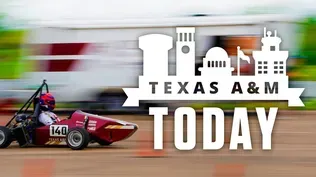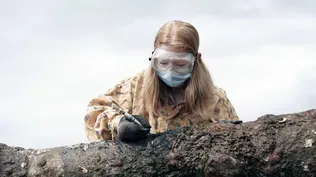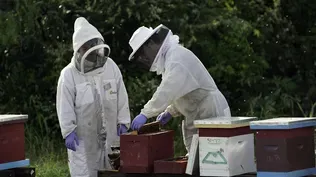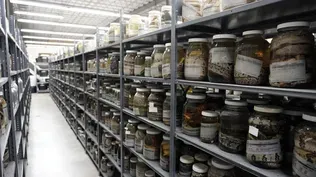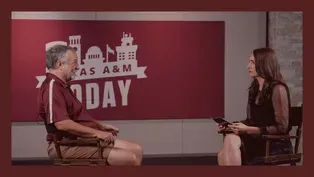
Ep. 1 - Conservation at Texas A&M
Season 2 Episode 1 | 29m 41sVideo has Closed Captions
Conservation at Texas A&M
In Episode 1, see how Aggies excel in preserving historical underwater artifacts with the Conservation Research Lab. Visit the 25,000 square foot Biodiversity Collection and the millions of specimens it houses. Find out why you should thank a bee and meet a mummy who once called Texas A&M home. Plus, watch a Q&A with the Texas State Climatologist, Dr. John Nielsen-Gammon.
Problems with Closed Captions? Closed Captioning Feedback
Problems with Closed Captions? Closed Captioning Feedback
Texas A&M Today is a local public television program presented by KAMU

Ep. 1 - Conservation at Texas A&M
Season 2 Episode 1 | 29m 41sVideo has Closed Captions
In Episode 1, see how Aggies excel in preserving historical underwater artifacts with the Conservation Research Lab. Visit the 25,000 square foot Biodiversity Collection and the millions of specimens it houses. Find out why you should thank a bee and meet a mummy who once called Texas A&M home. Plus, watch a Q&A with the Texas State Climatologist, Dr. John Nielsen-Gammon.
Problems with Closed Captions? Closed Captioning Feedback
How to Watch Texas A&M Today
Texas A&M Today is available to stream on pbs.org and the free PBS App, available on iPhone, Apple TV, Android TV, Android smartphones, Amazon Fire TV, Amazon Fire Tablet, Roku, Samsung Smart TV, and Vizio.
Providing Support for PBS.org
Learn Moreabout PBS online sponsorship- Howdy from Texas A&M.
We're on a mission to find the best and brightest at Texas A&M.
Taking you behind the scenes of one of the nation's largest universities.
In today's episode, we learn how A&M preserves and protects the earth and its heritage.
- I come home and I'm covered in cannon, and I just like, who else gets to do this?
- The more I learned about it, it actually just kind of like fed into this new interest and new curiosity about bees.
- Every time you open a case you see something new and I wish I could spend all day every day out here.
- Welcome to campus, welcome to Texas A&M Today.
Howdy, I'm your host, Chelsea Reber.
Today I am at the George H.W.
Bush Presidential Library and Museum on the campus of Texas A&M University.
This university is renowned in many areas, but one you may not expect is nautical archeology.
It's the restoration in conservation of artifacts found underwater, such as ships and cannons, and they're preserving centuries of lost history.
(gentle music) - Go to live capture, make sure that we're connected.
Nautical archeology is specifically looking at ships and ship architecture, so it's not just underwater archeology.
You can do prehistoric archeology underwater, but nautical specifically is looking at ships.
Alright, go ahead.
For me, when I wanted to come to grad school to study this topic, this was the only place I thought I wanted to go.
Like there was, there was no safety school.
This is it, this is the best.
It's, it's weird because A&M's known for so many things, but in my world, this is the Ivy League of underwater archeology.
- So I'm gonna take one of these waddings that was found in the inner bore contents.
(gentle music) The hidden history is what I really like.
I want to tell these stories.
When I started college, I knew I wanted to go into archeology, but I didn't know exactly what route I wanted to go into.
I didn't know if it was gonna be conservation or terrestrial or underwater, and so I was kind of like dabbling my feet into multiple fields.
I took a nautical archeology class of the Americas, and that's when I knew.
Everything just clicked and everything just fell into place.
No matter how cliche that sounds.
- We have three core staff conservators out here, and then everybody else that works with us is either an undergraduate or graduate student.
Conservation's one of those things that you can read about and you can learn about, but until you start to do it, it's just academic.
And so the reason that we've been so successful placing conservators in labs around the country and the world is because our students come and they actually come get their hands dirty here.
- It is really cool because we get to have all these projects geared towards us since we're one of the few who actually do it.
And then I get to use state-of-the-art technology like this FaroArm and DesignX to laser scan them.
So it's like combining multiple fields into one.
That's what archeology is.
We start using equipment that's designed in other fields and we use it to our benefit.
(gentle music) - A little precarious.
Let's see here.
(gentle music) I'm Catherine Duffy.
I'm chief curator for Coastal Heritage Society in Savannah, Georgia.
(gentle music) So in the early months of 2021, as part of the Savannah Harbor Expansion Project, they were doing some routine dredging investigation, and during this routine dredging, they pulled up three cannon and some anchors and halted this multimillion dollar production to do some further investigation, and they found that there was more than just one.
There were many, many cannons.
So the US Army Corps of Engineers became involved in the project, as did the Georgia Department of Natural Resources, and what was initially three ultimately became 19 cannon and dozens and dozens of artifacts that were recovered.
The amount of research that is being invested in the origins of these cannons is pretty significant.
It will provide a better understanding of first of all, their origin, where they came from, what they were used for, but also gives us tactile, tangible examples of this very important moment in our history.
This group of materials is not the first time Texas A&M University's conservation research lab has conserved items from the Savannah River.
In the years of 2015 to 2017, they recovered a Civil War ironclad ship called the CSS Georgia.
And so a lot of the materials that were recovered from the Georgia very close to where these cannons were recovered, went out to Texas A&M University, and also they somewhat recently finished a project conserving 25 iron cannons.
So it just seemed like the natural fit for these materials to go to Texas.
(machinery beeping) - We use mostly tried and true methods.
We do a lot of experimentation to improve those methods, but ultimately we tend to rely on the things that we know will get the job done effectively.
We are largely driven by the artifact itself, so it's not like I can just go through the steps and then bing bang, boom, it's done.
It's not up to us.
The artifacts drive the timeline.
- What's unique about these artifacts is that they've been in this stasis at the bottom of the Savannah River for hundreds of years, and so they require some additional care to stabilize them so that they can be put back on land and displayed in the museum.
- So when they come out of the water, they're covered in what we call an incrustation or concretion.
So as iron sits in water and it starts to corrode, a bunch of different things start to happen.
Sea life is attracted to that corrosion, so it starts to grow on that.
It also starts to fix minerals from the water, so calcium and magnesium, and build like a concrete shell around it.
For these cannons, they came to us concreted, and so our first step after we document everything really well is to remove the concretion, clear the bore, and then once the bore's clear, we put it into a, a vat of electrolyte.
It goes through a process called electrolytic reduction, where we use direct current to force the salts out of the metal and to stabilize the corrosion products that are there.
The additional step that we're taking is to laser scan all of them before they go in, so we can also laser them, laser scan them when they come out and see if there's any appreciable difference, which I don't expect there to be.
(hammer thudding) - When we're de-concreting them and we're hitting them with the hammer and we hit the surface, we're the first people to see that surface.
And it's just, it's a lot of firsts that are a wild experience to me.
And we learn about all these histories like with stories and textbooks and TV, but to be the actual physical one getting dirty and doing it all, it's everything I wanted to do.
- Things that come through the lab, we're the first people to, to make new discoveries about these things since they were lost.
So like for these cannons, when we open up the barrel, we're the first person to see in that barrel since they were loaded 250 years ago.
And yeah, there's been times where you, at the end of the day, you're home and you're pulling splinters from 17th century ships outta your hand and you get kind of grumbling about how much it hurts or how dirty it is or how late you had to work, and then you kind of, oh right, that's actually pretty freaking amazing.
So it's something that we all, I think enjoy balancing.
- It's, it's really exciting to be part of something that's much bigger than our museum, much bigger than Savannah, much bigger than Georgia.
It's, it's a really national coming together.
And so with the scope of this collection, these huge cannons done, you know, decorating the museum, I think that awestruck moment is going to be that much more amplified.
- Although this is their home base, Dr. Dostal and his team go wherever the work takes them.
Last year that was Quebec.
This year it's Spain.
Now it's time for an Aggie fact.
(gentle music) Texas A&M owns an Egyptian mummy and there are conflicting accounts of the lore behind it.
Around the 1910s, the first dean of the school of veterinary medicine, Mark Francis, bought a mummy and brought it to campus.
Its legend grew.
The mummy was falsely labeled a tax collector for an Egyptian pharaoh.
The hieroglyphics on the coffin were roughly translated giving the mummy its first name, Anh-HR-H3CPJ.
It soon became tradition to force freshman cadets to memorize the name and recite it on command when asked who is the oldest man on campus?
When Dr. Francis died in 1936, he donated his collections to the university.
For nearly three decades the mummy lived in a campus museum where the Linkford Architecture Center now stands.
But the mummy fell into disrepair.
Researchers later used CT scans to learn that bones had moved, the jaw had been stolen, and wasps took up residence in its head.
In 1970 A&M shipped the mummy to the Houston Museum of Natural Science, where it remains on permanent loan today in the hall of ancient Egypt.
That's where the hieroglyphics were correctly translated, giving him the name Ankh-Hap.
The mummy's tale is so strange, it's the subject of a new book coming out later this year.
For every three bites of food you eat, you should think a bee.
That's because about a third of the food we eat wouldn't exist without pollination conducted by bees, but they're increasingly in danger.
Researchers across the country, including at A&M, are trying to save them from humans, malnutrition, and perhaps their biggest threat, an invasive parasite.
(gentle music) - There's always something new you learn about bees.
Some things are unexpected.
Did you know that drone honeybees, which are the males, cannot sting?
Did you know that most of the bees that you see on flowers, 99.999% are female?
(gentle music) - There's no limit in terms of what I can learn from honeybees.
How does that work?
Well, how does this happen?
Wait, how does that work?
And just, you know, just being that curious, just keep getting more curious.
- All of these bees are working together towards like one productive end and understanding kind of how they're doing that, what's happening in a way that like we totally don't understand.
There's a lot of things that are happening that we can't see.
A lot of things that are happening that we don't even really know about.
(gentle music) - We are the only apiculture program in the state of Texas.
For as large as the state is, there are other people that study some aspects of honeybee biology in other universities, but we are the apiculture program at A&M.
Some people have to keep the bees in a field and then put a shed next to it or share the facility with other researchers.
And we don't have to do that.
We're really, we're really privileged.
- You don't think about bees when you're, you know, eating dinner, but bees have been really integral to, to your dinner, to your breakfast, to every meal that you eat.
Bees are kind of there in the background.
- It has been estimated that honeybees provide about $16 billion annually to the US economy, primarily through the pollination of major agricultural crops.
For the mere importance of maintaining ecological balance and conservation of biodiversity, honeybees are incredibly important.
(gentle music) We're in an important moment in the history of beekeeping.
Varroamite is the number one problem in apiculture today.
It attacks the bees, it feeds off of some of its body tissue, but it also transmits several dozen honeybee associated viruses.
In the last three, four decades, we've been just trying to play catch up, trying to find innovative ways to get rid of the varroa mite.
Understanding its biology will help us better protect the honeybee.
- The varroa mites are ecto parasitic mites on honeybees and so they are pretty big.
They feed on the honeybees and so if it was like parasitizing me, it'd be the size of a big basketball on me.
- It's almost in every colony in the United States.
And we have roughly 2.8, probably 3 million colonies in the United States.
And I would say that nearly all of them have some level of varroa mite infestation.
- Pre varroa mites, there's tons of studies that have shown there have been, you know, low levels of viruses present in honeybee colonies.
But after these varroa mites were introduced, the viral levels in honeybee colonies has just skyrocketed.
We have chemical protections, but we use them so frequently that resistance has evolved quite quickly by the varroa mites.
You can imagine that if you have a ton of stressors in a colony, a ton of bees leaving the colony early, they're dying in the field.
Then even younger bees are having to age up to take on this role because they need foragers.
This could lead to basically the symptoms of a colony collapsing because you lose just the entire adult population.
Hopefully by kind of looking at these actual evolved responses in other honeybees, we can kind of apply that to our honeybees in a way that could be over time sustainable.
- We have gotten to a point where we have sufficient knowledge about this devastating parasite that we are doing better at controlling it.
- We do have some and high treatment options and some beekeeping practices that we can use to help keep varroa mites at bay, but it's a continual fight.
And so that's probably the one of the biggest things that a lot of beekeepers are concerned about is the level of parasites that are in their colony.
- Over the next 10 years, we're gonna find different chemistries and treatment options that will help us improve our odds in combating the varroa mite, plus other pathogens that that we have attacking the honeybee.
One of my favorite parts of my job is to train the next generation of scientists, especially honeybee scientists.
Having different people from different backgrounds come together helps improve the number of questions and the diversity of answers that we could provide to these scientific inquiries.
- The first summer, you know, I was just kind of thrown into it and had to learn pretty quickly and, and I was just amazed at what I didn't know and what the insects are capable of doing.
It actually just kind of like fed into this new interest and new curiosity about me.
At the end of the semester I ask them, what did you learn?
Like, did your perception change?
And a lot of them are like well, I'm not as scared as I used be.
So that's good.
But also they're like I was just unaware of how much that we can learn about bees.
- We learned several fun facts about bees while visiting with the research team, and we wanna share them with you.
Go to our website and search bees to learn more.
Next, humans have been captivated by maps for millennia.
They make it easy to explore and navigate our world.
Texas A&M University libraries has collected more than 250,000 maps, but what if I told you some of them aren't based on real places?
(gentle music) At first, they look like any map you've ever seen, with roads, buildings, terrain, and planets.
But look closer and you'll realize that Texas isn't the Texas we know, Great Britain looks more like Westeros, and maps of the cosmos have a few interesting additions.
This is the Maps of Imaginary Places collection.
- So this for example, this is a rather large map.
This is Ankh Morpork which is the major city in Terry Pratchett's Discworld.
- They're are purchased from dealers, donated by collectors, or purchased directly from artists.
Texas A&M University libraries continues to grow their collection of about 600 fictional maps.
There are maps of literary history.
I actually recognize titles on this, that excites me.
Maps of concepts, allegorical maps, and maps from every medium you can think of.
- There's maps from literature, that's probably the majority of them, but there's also maps taken from television sources, movies, video games, role playing games, all kinds of stuff.
- Well I would love to see some.
- Yeah, I've got some actually upstairs that's kind of a cross section of the collection for you to see.
- Collection curator Jeremy Brett says they have maps dating back to the 16 and 1700s, like a map of herbal medicines assigned to the four elements.
- It helps you visualize this concept, which in a more fun, memorable way than just here's my list.
- And there are plenty of new maps from video games and movies.
I am completely geeking out over this one.
The Marauder's Map from Harry Potter.
There's an interactive Pirates of the Caribbean map.
- Map turns and spins, and it's kind of another way of showing that maps aren't necessarily static, right?
Maps change, maps can, you know, routes change, destinations change.
- There truly is no limit to the variety of the collection.
- I mean you can see from this table there's all kinds of different things, different sources.
- Yeah, I was gonna say, I recognize Home Alone.
- Right, so another example of a map that charts an event, right?
So this, you know, tracks Kevin's progress with the, with the burglars in Home Alone.
- One of the most popular maps is also one of Brett's favorites, an exhaustive summary of zombies.
- And what's interesting is every possible iteration of a zombies in here it seems like.
And what's interesting, if you get to the end of every branch, Jason has gone into trouble of finding a reference, whether it's a book or a TV show, or a movie or video game, to link to find that particular kind of zombie.
- English and cartography students use the collection for research.
Brett says the maps are also sources of inspiration.
- Using these as models, people can make their own maps to sort of create their own visualizations about their lives.
- As the collection continues to grow, Brett hopes more people will discover and find joy in their favorite maps.
- We have a huge and well-respected map collection.
So many sources have maps, so books have maps and television shows have maps and comic books and video games, all these things.
So it's clearly the maps are an important part of that product.
And so having those maps is telling part of their story also.
- We're onto a different kind of collection now.
One that fills 25,000 square feet with more than two million specimens.
Birds, fish, amphibians, reptiles, mammals, and invertebrates.
Each specimen is carefully handled and preserved for research and teaching about life on earth.
- I feel like when people hear the word museum, they think of something that's maybe static, antiquated, not changing.
But in terms of collections and natural history collections, that word collection I think implies that it's more dynamic and constantly changing.
The Field Museum in Chicago or the Smithsonian in Washington DC or the American Museum up in New York, those are big exhibit museums and behind a lot of their exhibit walls are collections just like ours.
- This collection is like a library of nature.
Scientists can check out our specimens, borrow them if you will, just like you would borrow a book from a library.
And scientists can study our specimens so that we can learn more about the species that they represent.
- In the whole collection, we have millions.
You'll get a very, some striking numbers from fishes and herps.
They have many specimens 'cause they're able to collect many at once.
So in total, we definitely have several million.
(gentle music) - The collections last forever.
There's great responsibility with that.
So every single aspect of curation involves a long legacy of about 300 years of how to take care of this material so that it lasts forever.
Every bit of thread, every type of ink, every type of paper, even the jars, the lids that go on the jars, everything is planned and thought out so that, so that the collections are secure.
These collections are used on a regular basis by anthropologists all the way to zoologists and zookeepers.
- We've been able to generate 3D data sets of hundreds of specimens.
These data sets are available online.
Anyone in the world can access them as long as they have a computer and access to the internet.
It's not only scientific researchers that are examining our specimens.
(gentle music) - The basic function of any research collection is, is to get a specimen through the preparation process and fully cataloged and assign that final museum voucher number.
Every semester we have students that are either interning or being paid, undergraduate students that are doing the bulk of the maintenance of the collection.
So we have some that are preparing specimens.
We have some that are doing data entry.
We have some that are installing specimens.
So by virtue of that, we're basically exposing the collection to a new audience.
(gentle music) - Students can kind of be the livelihood of this place because it's a big collection for each curator.
So students can help out a lot in managing that and organizing it.
I never even thought of museum curation as an option for me as a career, but with this opportunity from just volunteering, I was able to open my own doors in a way.
I chose this, this path, this conservation path when I was very, very young.
So I, it's never been a second thought for me.
Even though it's not direct and dirty work, it's still important and it holds value for conservation.
I do this for a purpose, I do this for the animals, for preserving the natural world and everything I do serves that goal in some way.
(gentle music) - Collections are, you know, really part of everything.
It's just that people don't realize it because you pick up a field guide and you're reading a field guide, you don't realize that the connection goes all the way back to that, you know, the 16th jar on the third shelf on the fourth row in the back of that collection.
It's still cared for and used by people.
- Every time you open a case, you see something new.
And I wish I could spend all day every day out here.
It's a lot of fun to make new discoveries using specimens in natural history collections.
And that can happen hourly, if not more frequent than that depending on how close you look at the specimens and their data.
- It's important to keep growing these collections because we can find out more information.
As people figure out new lines of research, we can disseminate more of that material from a given specimen to more researchers than we've been able to in the past.
(gentle music) The importance of the collection just keeps increasing because these specimens are so valuable and we have no idea what uses people are gonna think of for the collection in the future.
We just know they're gonna keep thinking of more, more and better uses for the collection to document all these changes that are happening, you know, across the planet and across Texas.
- If you'd like to support the research and student training happening at the collection, visit the Texas A&M Today Show page on our website.
We've put up a link where you can donate.
Next I caught up with a Texas A&M difference maker for a one-on-one conversation.
Today that's Regents professor of Atmospheric Sciences and Texas State climatologist, Dr. John Nielsen-Gammon.
He's been teaching and conducting research at A&M since 1991.
As the state climatologist, what are your goals when it comes to sharing what you learn and know and observe with the public?
- My one sentence mission statement is to help the state of Texas and its people make the best possible use of weather and climate information.
With climate and climate change having become somewhat politicized recently because of all the issues related to it, I think it's important that somebody be a reliable source of information for anybody who, who needs the information and not put a slant on the data or the information or the implication.
- Perhaps two of the most contentious words going on right now, and that is climate change.
At a very basic level what does that term mean?
- In our present time and present understanding, it's essentially referring to how the entire climate system is changing due to changes in the composition of the atmosphere primarily.
So what's happening now is, is fairly unusual in that, well it's never happened before in just this way, and it makes it kind of hard to predict what the outcomes are going to be.
Good news is we won't be seeing a Harvey every day.
Bad news is intense rainfalls increasing by about seven or 10% for every degree of global warming we get.
So those run of the mill floods are gonna become more common and devastating floods are expected to become more frequent.
- We've been through multiple record breaking summers recently.
Can we expect that heat to keep getting higher?
- You know, if you think forward to the middle of the 21st century will be three degrees above our 20th century average normally.
And then the high temperatures, the hot summers will be four or five, maybe six degrees above the 20th century average.
So this is, the summers we've seen in 2022 and 2023 are not the new normal yet.
They are the new abnormal and they're on their way to becoming the new normal.
- Climate change is constantly in the news.
What should people be taking away from that widespread coverage?
- It's tough because, you know, every news source has its own perspective on what's important, what information needs to be conveyed to the public.
Really the best, the best advice I can give is to take the long view, look at what's happened over a long period of time.
- What worries you about the future of our planet?
- Our planet's gonna do fine.
It's the people on it that are gonna have to deal with it.
We've also got war, we've got disease, we've got famine.
All of these are pressing problems.
At least climate change is, unlike say war or disease or famine, something you can actually work out solutions to and implement.
You know, people are complicated.
Climate is relatively simple.
- Well Dr. Nielsen-Gammon, thank you so much for joining us today on Texas A&M Today.
- Thanks a lot.
- You can watch the full version on our website.
That's it for this episode of Texas A&M Today.
You can watch all past episodes on pbs.org or our YouTube channel.
Gig 'em.
(gentle music)
Extended Cut: Dr. John Nielsen-Gammon Interview
Video has Closed Captions
Watch Chelsea’s full interview with Texas State Climatologist, Dr. John Nielsen-Gammon. (35m 31s)
Providing Support for PBS.org
Learn Moreabout PBS online sponsorshipSupport for PBS provided by:
Texas A&M Today is a local public television program presented by KAMU
